ASTROnline
Editor's Note: In December 2011, Glenda E. Gill
proposed to write an article for this special issue of
ASTROnline on drama programs at historically Black
universities.
As
our team worked with Professor Gill, it emerged that she
grew up as the child of faculty and staff members at
Alabama A. and M. College, her mother, Olivia Dunlop
Gill (Business Department), and father, Melvin Leo Gill,
Sr. (Campus Postmaster). When it became clear how
interwoven her own biography was with the subject of her
article, we proposed that we turn her article into an
interview about her life’s journey.
Glenda E. Gill taught college, full-time, for 40 years
at institutions including Alabama A & M College (now
University), University of Texas at El Paso, Tuskegee
Institute (now University), Winston Salem State
University, Simpson College, and Michigan Technological
University. She retired in 2006 as a tenured full
professor from Michigan Tech, where was she was awarded
Emerita status that same year.
An ASTR member since 1983, she has spoken at over fifty
venues, including the World Congress of Theatre in
Stockholm (1989) and Dublin (1992), the Eugene O’Neill
International Conference in Tours, France (2003),
Provincetown (2005) and San Ramon, California (2008).
Her honors include giving the Ralph Ellison Lecture at
Tuskegee University in 2007 and participation in four
National Endowment for the Humanities (NEH) summer
seminars at Iowa (1974), Yale (1985), UNC-Chapel Hill
(1989) and Duke (1991) as well as serving as a 1990
Summer Fellow at the National Portrait Gallery of The
Smithsonian Institution. She has held Rockefeller and
Roothbert grants, in addition to research grants from
Michigan Technological University.
Her articles and reviews have been published in Theatre
Survey, Theatre Journal, Journal of American Drama and
Theatre, The Drama Review and The Eugene O’Neill Review
among others. She is the author of No Surrender! No
Retreat! African-American Pioneer Performers of Twentienth-Century American Theater (St. Martin’s Press,
2000) and White Grease Paint on Black Performers: A
Study of the Federal Theatre, 1935-1939 (Peter Lang,
1988).
CM: Can you describe the experiences of growing up on
the campus of Alabama A. and M. College in the 1940s and
1950s? What did it mean to you to be the child of a
faculty member at a historically Black university during
segregation?
|
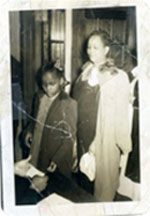 |
|
Glenda Gill and Olivia Dunlop
Gill at a Roland Hayes concert,
circa 1946 |
GG: We had faculty housing—substandard, but on campus.
Rents ranged between $12.00 and $25.00 a month. Most
housing in Huntsville was not available to blacks then.
The main advantage of being the child of a faculty
member to me was that I had an opportunity to see a vast
array of artists and speakers come to campus: Langston
Hughes, Marian Anderson, Adam Clayton Powell, Jr., the
Shakespearean Players of Catholic University, the dePaur
Infantry Chorus, and the Huntsville Symphony, among
others. These were free through our Lyceum Series. I
started as a young child seeing Roland Hayes, the great
tenor. My mother, Olivia Dunlop Gill, the faculty
member, accompanied me. Mr. Hayes had one of the
sweetest tenor voices I have ever heard, the other being
that of Luther Saxon who played Joe in the 1943 Black
adaptation of Bizet’s opera, Carmen Jones, which I also
saw at Alabama A. and M.
CM: How did you become exposed to theatre through
your experience of growing on a university campus? Can
you describe your early experiences in theatre? (The
plays that you did, the roles that you played, the
philosophy of theatre that you were exposed to through
these productions?)
GG: The philosophy was that drama was universal. We were
brainwashed to believe that only White was right in
those years, so all Black casts put on plays only by
White authors. Of the Black playwrights who had written
plays, few had their works published and available. I
performed in eight plays with the Alabama A. and M.
Thespians, first as an adolescent and then as a college
student. My plum role was that of Mrs. Phelps, the
Cannibal Mother who devours her sons, in our 1957
production of Sidney Howard’s The Silver Cord, directed
by Dr. Fannie Ella Frazier Hicklin, now 93. Charles L.
Ray, Jr. co-starred as my younger son, Robert.
As a teenager, I went to Broadway every summer, staying
with my Aunt Eleanor and Uncle Scott. I worked for fifty
cents an hour in the Alabama A. and M. Library as a
college student, rode the bus to New York and saw plays.
CM: What was your awareness growing up of programs or
activities in theatre and drama at other historically
Black colleges and universities? What kinds of networks
enabled the transmission of this knowledge? What kinds
of connections have you made with these programs
throughout your career?
GG: My friend, Joan Carter, went to Fisk. I learned
about Lillian Voorhees, director of the Fisk Stage
Crafters, through her. I remember the legendary Thomas
Poag of Tennessee State University in Nashville bringing
See How They Run to Alabama A. and M. when I was a
child. I recall Howard University bringing Tennessee
Williams’s The Glass Menagerie. Maggie McCalep, a
faculty wife, jumped from her seat in the audience when
the character playing Laura fell. Maggie thought the
fall was real; she rose to rescue her.
I also chaired the Department of English and Foreign
Languages at Tuskegee Institute (now University) between
1982-1983 before the Little Theatre was destroyed and
witnessed a flawless production of Charles Fuller’s
Zooman and the Sign, directed by Archie Simpson. I have
published on Howard University’s 1944 production of
Eugene O’Neill’s The Homecoming, the first in the
trilogy of his Mourning Becomes Electra. I directed a
Reader’s Theatre production at Winston-Salem State
University, Bare Floors and Purple Carpets: The Passage
of the Black American in 1985.
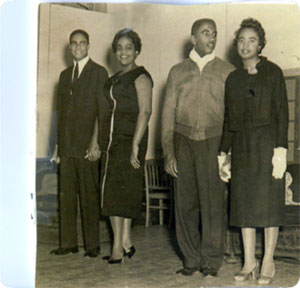 |
|
Sidney Howard’s The Silver Cord at Alabama A & M
Directed by Fannie Ella Frazier Hicklin; December 1957
(L-R: Charles L. Ray Jr. as Robert; Glenda Gill as
Mrs. Phelps; Robert Jamison as David;
Arleatha Goudy as Christina) |
CM: What role did the other arts such as music or dance
play in your early life and how did Alabama A. and M.
foster an overall experience of the arts?
GG: Music on the HBCUS has historically been uplifting.
I sang in the Alabama A. and M. College Choir under the
direction of Mrs. Nell Lane Bradford. It was a
transforming experience. We learned all kinds of music
including the Negro spiritual. Dr. Elsie Hill Wallace,
an extraordinarily gifted pianist on campus, taught me
how to play the piano, starting when I was five years
old. My mother bought a Wurlitzer piano and a metronome.
I heard the great contralto Marian Anderson in 1954 when
I was thirteen years old at the Alabama A. and M.
Gymnasium. I can hear the rumbling of the piano now as
she started to sing The Erlking. I see her sweeping
across the stage, moving into the neck of the Ebony
grand in her elegant brown evening gown with a train and
motion to Franz Rupp to begin playing. She used art as a
weapon.
I actually danced in high school—creative dance and
loved to dance to the music of Don Q on Saturday night.
But I also saw Talley Beatty in 1949 at the Lyceum
Program in his famed Tropicana. Pearl Primus came, as
well. Alexandra Danilova, the great ballerina, graced us
with her presence. In later years, I saw Alvin Ailey.
CM: Your B.S. (Alabama A. and M.) and M.A.
(University of Wisconsin-Madison) were both in English.
How did theatre factor into your education in this
discipline in the 1960s?
GG: I acted in plays at both schools. I witnessed good
theatre, amateur and professional, at both places. At
Wisconsin-Madison, I played the maid, Cleota, in Thurber
and Nugent’s The Male Animal (1962), directed by Lowell Manfull. Daniel Larner played the protagonist, Tommy
Turner. Non-traditional casting was extremely rare,
then, but six months later, Ronald Mitchell cast me as
an elderly lady and in other bit speaking parts in
Bertolt Brecht’s epic, Galileo (1962). This was very
unusual for the times.
CM: Who were your heroes and role models in academic
theatre throughout your early training and career?
GG: Dr. J. Preston Cochran and Dr. Fannie Ella Frazier
Hicklin. Cochran, a creative genius, was born in
Gadsden, Alabama, in 1926 and is now deceased. He
directed 20 extraordinary plays at Alabama A. and M. in
five years (1949-1954). I was in four of those as an
adolescent. Cochran held a B.A. from Morehouse College
in Atlanta, an M.A. from Atlanta University and a PhD
from Iowa (1958). At Iowa, he played the title role in
O'Neill's The Emperor Jones in 1955 and the title role
in Shakespeare's Othello in 1957.
|
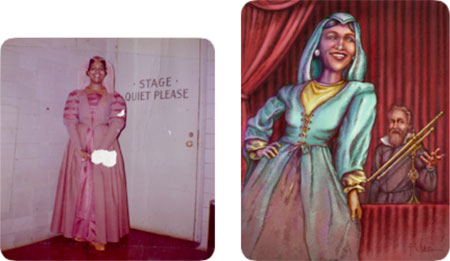 |
|
Glenda Gill in Galileo,
University
of Wisconsin-Madison, 1962 |
Caricature by Rick Nass |
Dr.
Fannie Ella Frazier Hicklin is an active 93 year-old
living in Madison, Wisconsin. She taught English and
directed the Alabama A. and M. Thespians from 1956-1961
and I was in three of those productions in college. Dr.
Hicklin has an undergraduate degree from Talladega
College, an M.A. from the University of Michigan and a
PhD from the University of Wisconsin-Madison. She worked
on the faculty and as an administrator for over twenty
years at Wisconsin-Whitewater where a studio theatre is
named in her honor. She wrote the definitive
dissertation on the American Negro Playwright,
1920-1964.
CM: Your two books, “No Surrender! No Retreat!
African-American Pioneer Performers of Twentienth-Century
American Theater” (St. Martin’s Press 2000) and “White
Grease Paint on Black Performers: A Study of the Federal
Theatre, 1935-1939” (Peter Lang 1988) have both focused
on retrieving the histories of Black actors’ careers.
For you, how does studying individual performers and
their networks serve the field of Black theatre and
performance history more broadly? Is there any one
individual you have written about over the years that
you feel proves particularly exemplary of the power of
biographical approach? If so, who are they?
GG: My work investigates the dynamics of race, gender
and class and how they intersect with the
African-American in the performing arts, especially in
non-traditional roles. I think that my most powerful
biographies are of Canada Lee and Paul Robeson, both of
whom were destroyed by their activism. One cannot be
both actor and activist in many instances.
I found a treasure trove of Lee’s papers in 1980 when
his widow and I unearthed five file boxes which had lain
dormant since his 1952 death and our gathering them in
June of 1980 from fellow actor Tommy Anderson’s garage.
A complete listing of those materials is now on the
website at The Schomburg Research Center for Black
Culture in Harlem.
CM: Your teaching career has spanned almost half a
century at a number of different teaching institutions
before your retirement from Michigan Tech as a tenured
full professor in 2006. What were some major highlights
of your experiences in these many years with students
and colleagues? How did you navigate working with
different institutions and their varied student
populations?
GG: Although I never taught in a theatre department, at
each university or college where I worked, I sought to
connect my interest in theatre with the interests of the
students. That was not hard at Simpson College in
Indianola, Iowa, where a number of students majored in
music. I did a class called “In Search of Self Through
Performance of Drama” with a culminating readers'
theatre production, Revelations.
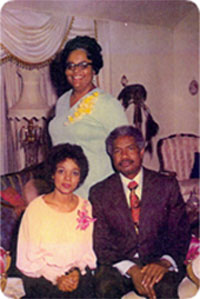 |
|
Glenda with Ossie Davis and Ruby Dee
at a Delta Sigma Theta sponsored
reception following their reading at the Plaza
Theatre, El Paso, 1975 |
More
challenging would be connecting my theatre interests
with engineers. At Michigan Tech, I saw students do an
outstanding film, "Othello, the Moor of Michigan Tech"
and saw them execute a brilliant original drama where
King Lear gives away the Kewadin Casino and other places
in the Upper Peninsula to Goneril and Regan. The four
students dressed in Yooper outfits - orange snowsuits.
It was extraordinary. I did similar projects with
military men and women at Fort Bliss Army Extension of
the University of Texas-El Paso - I used Howard
Gardner's theory that there are seven intelligences and
I sought to nurture those in each student I taught.
CM: What role did professional development through
organizations like ASTR or participation in the National
Endowment for the Humanities Summer Seminars play in the
journey of not only your research but teaching and
relationship to the field as a whole?
GG: ASTR was of immeasurable value in my teaching and
research. I was on a Shakespeare panel in 2001 at an
ASTR meeting in San Diego; I taught Shakespeare at
Tuskegee and Michigan Tech - I spoke in 2001 at ASTR
only on James Earl Jones's portrayal of Othello which I
saw on Broadway in 1982 - participation in ASTR seminars
enriched my teaching because of what I learned from
others and made me even more enthusiastic.
One of my NEH institutes was at Duke University in 1991
- "Interpreting the African-American Experience Through
the Performing Arts, 1890-1990." That extraordinary
experience exposed me to a great deal and created
sustained connections - dancers Talley Beatty and Pearl
Primus among many other dancers. Almost daily, I talk
with Mical Whitaker whom I met there - about what works
in the classroom and on stage. It is crucial to be
connected to the larger world of theatre.
|
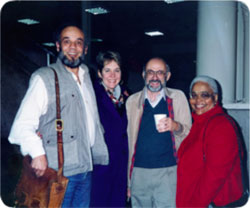 |
|
Glenda Gill with Freddie Rokem, Janelle
Reinelt, and Tom Postlewait at the International Federation for Theatre Research
at Trinity College, Dublin, 1992 |
CM: You have written a memoir entitled “Pebbles in My
Shoe: The Journey of One African-American Woman of the
South” that has been deposited with Nena Couch, Curator
of the Lawrence and Lee Theatre Research Institute at
The Ohio State University, to be opened only after your
death. In the preface that you shared with me, you write
about wanting to tell your story in order to share the
‘emotional and financial toll on one person.” Can you
talk about what you mean by this and why your story is
important in the context of the past, but the future of
academia?
My
memoir chronicles many glorious major moments but I,
like many others, especially African-Americans,
experienced the revolving door more than once. This is
universal. Times have never been easy in academia. They
are even worse now.1 When education becomes as
important to most Americans as prisons and football, we
will be a more civil, stable nation. But the dearth of
money is not our only concern. We need to conquer the
racial divide, class warfare, sexism and homophobia as
well.
NOTES
1In 2009, only 27% of U.S. faculty held tenure-track
positions, compared to 75% in 1960. Samantha Stainburn,
“The Case of the Vanishing Full-Time Professor,” The New
York Times, December 30, 2009, accessed August 5, 2011,
http://www.nytimes.com/2010/01/03/education/edlife/03strategy-t.html?ref=education.
*Reprinted with the generous permission of
ASTROnline.